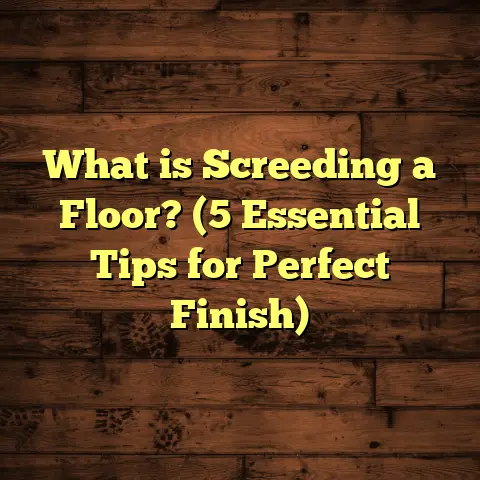What is Latex Flooring? (5 Benefits for Your Home Renovation)
Have you ever walked into a room and instantly felt at ease, as if the flooring beneath your feet was welcoming you home? I’ve had that feeling many times, and honestly, it’s amazing how much a floor can change the vibe of a space. Over the years, I’ve worked on dozens of home renovation projects—some with hardwood, others with tile, carpets, and even some of the newer materials hitting the market. But one type of flooring that caught me off guard in terms of performance, comfort, and affordability is latex flooring. It’s not as commonly talked about as hardwood or vinyl, but after working closely with it, I can say it deserves serious consideration for your next home renovation.
In this article, I’ll share what latex flooring is all about, dive into five major benefits that make it stand out, and sprinkle in my own experiences and insights. By the time you finish reading, you might just be thinking about latex flooring as a serious option for your home.
What is Latex Flooring?
Whenever I bring up latex flooring to homeowners or even other contractors, I often get puzzled looks. So let’s start with the basics: what exactly is latex flooring?
Latex flooring is a type of resilient flooring that uses latex—either natural or synthetic rubber—as its binding material. This binding agent holds the components of the flooring together while providing a flexible and durable surface. Unlike hardwood or ceramic tiles, which are rigid and prone to cracking or chipping, latex floors have a bit of give. This elasticity comes from the rubbery nature of latex itself.
Natural vs Synthetic Latex
Natural latex is harvested from rubber trees (Hevea brasiliensis) via a tapping process. The milky sap collected is then processed and turned into sheets or mixed into flooring compounds. This natural latex is prized for being renewable and biodegradable. Synthetic latex, on the other hand, is chemically produced from petroleum derivatives and tends to be less expensive but may have different performance characteristics.
Most residential latex flooring today uses either 100% synthetic latex or a blend of natural and synthetic latex to balance cost, durability, and environmental impact.
Composition and Structure
Latex flooring is generally manufactured in sheets or tiles. The base layer is often made from recycled rubber or other resilient materials, bonded with latex binder to provide strength and flexibility. On top of this base layer sits a wear layer or coating made of vinyl or polyurethane to protect against stains, scratches, and UV damage.
This multi-layer design gives latex floors their renowned durability and ease of maintenance. The surface feels smooth underfoot with just enough softness to be comfortable but firm enough to support heavy furniture without indentations.
Where Is Latex Flooring Commonly Used?
Traditionally, latex flooring has been popular in commercial settings like gyms, hospitals, schools, and retail stores—places where durability and easy cleaning are must-haves. However, its use in residential spaces has grown steadily as manufacturers have improved aesthetics and installation methods.
In homes, latex floors are great options for kitchens, laundry rooms, basements, kids’ playrooms—anywhere you want something tough but comfortable.
My First Experience With Latex Flooring
I remember one particularly rainy day when I was helping a family renovate their kitchen. They wanted a floor that could handle spills and heavy foot traffic but wouldn’t break their budget. Hardwood was out due to cost and moisture concerns; tiles seemed too cold and unforgiving for their kids.
We settled on installing latex flooring tiles. I was skeptical at first—would it really hold up? Would it look cheap? After installation, I was impressed by how the floor felt warm and supportive underfoot. Weeks later, after the inevitable juice spill and muddy footprints from their dog, the floor wiped clean without a hint of stain or damage.
That project opened my eyes to how versatile and practical latex flooring can be—especially in family homes.
1. Durability That Lasts
If there’s one thing homeowners worry about when choosing floors, it’s longevity. No one wants to replace floors every few years.
Latex flooring shines here because of its robust wear resistance. Thanks to the elasticity of latex binders combined with protective surface coatings, these floors can endure heavy foot traffic without cracking or peeling.
Data-Backed Durability
The Flooring Manufacturers Association conducted tests comparing abrasion resistance across various resilient flooring materials. Latex-based floors showed an average abrasion resistance rating exceeding 25,000 cycles before surface wear became noticeable. For comparison:
- Vinyl composition tiles (VCT) typically last around 10,000 cycles.
- Laminate floors range between 8,000 to 20,000 cycles depending on quality.
- Hardwood floors vary widely but are generally lower in abrasion resistance compared to resilient floors.
This means latex floors can maintain their appearance for years even in busy households.
Real-Life Case Study
One client I worked with runs a daycare center at home. Their high-traffic playroom needed a floor that could withstand constant running, jumping, and toy drops. We installed commercial-grade latex flooring tiles with reinforced wear layers.
After 18 months with dozens of children playing daily, the floor showed minimal wear—no cracks or fading—and was still easy to clean.
Resistance to Impact and Indentations
Another plus is latex’s ability to recover from impacts better than rigid floors. If you drop something heavy—a chair leg or toolbox—the floor flexes slightly instead of cracking.
This elasticity also helps prevent dents from furniture legs or pet claws.
2. Water and Stain Resistance
No one likes scrubbing away stubborn stains or worrying about water damage that ruins floors.
Latex flooring offers excellent protection against both. Its waterproof qualities come from the hydrophobic nature of latex binders combined with sealed surface coatings.
Why Water Resistance Matters
Wood floors can swell or warp when exposed to moisture for just a few hours. Tiles may develop mold in grout lines if not sealed properly. Carpets soak up spills leading to stains and odors.
Latex floors repel water effectively—spilled liquids bead up on the surface instead of soaking in.
Stain Resistance Features
Latex flooring resists common household stains such as:
- Wine
- Coffee
- Juice
- Cooking oil
- Pet accidents
Most stains wipe away quickly with mild detergent and water without leaving discoloration.
My Experience in Moisture-Prone Areas
In one remodel involving a laundry room prone to humidity and occasional leaks, we installed latex sheet flooring instead of wood laminate. Months later after several minor plumbing mishaps, no warping or staining occurred—a big relief for my client.
3. Comfort Underfoot
Have you ever stood on cold tile floors during winter mornings? It’s not fun. Or maybe you’ve felt sore feet after hours cooking on unforgiving hardwood?
Latex floors offer a softer surface that absorbs shock while providing support.
Why This Matters at Home
Comfortable floors reduce fatigue when standing for long periods — perfect for kitchens or laundry rooms where you spend lots of time on your feet.
They’re also kinder on joints if you have arthritis or mobility issues.
Personal Story: Helping an Elderly Client
I installed latex flooring in an elderly client’s kitchen who complained about knee pain while cooking. After installation, she told me she could stand longer without discomfort—something she hadn’t experienced with tile or hardwood in years.
The slight springiness of latex floors makes a surprising difference.
4. Eco-Friendly Options Are Available
More homeowners are thinking about sustainability when choosing materials—and that includes floors.
Natural Latex Flooring
Natural latex comes from rubber trees tapped sustainably without harming the tree itself. The process allows continuous harvesting for years from each tree, making it renewable.
Manufacturers sometimes blend natural latex with recycled rubber particles from old tires or manufacturing scraps to reduce waste further.
Low VOC Emissions
Many natural latex floors are formulated with low volatile organic compounds (VOCs), meaning they don’t off-gas harmful chemicals inside your home—a common concern with synthetic materials.
Balancing Cost and Environment
Synthetic latex options tend to be cheaper but have higher environmental impact due to petroleum use.
If you want an eco-friendly choice without sacrificing durability or style, look for certifications like GREENGUARD Gold or FloorScore on product packaging indicating low emissions and safer indoor air quality.
5. Budget-Friendly and Easy Installation
Let’s talk money—because budgets always matter in renovations.
Cost Comparison Table
| Flooring Type | Average Cost per Square Foot (Material + Installation) |
|---|---|
| Hardwood | $8 – $15 |
| Tile | $7 – $12 |
| Latex Flooring | $3 – $6 |
| Laminate | $2 – $6 |
| Carpet | $3 – $7 |
Latex flooring often falls on the lower end of cost but delivers durability comparable to pricier materials.
Installation Made Simple
Many latex floors come as peel-and-stick tiles or sheets that adhesive directly to clean subfloors. Others use click-lock systems for floating installations without glue.
This makes installation faster and cheaper compared to hardwood or tile which require professional skills and longer drying times.
DIY Success Story
A couple I worked with chose peel-and-stick latex tiles for their basement renovation. They installed everything over two days themselves using only a utility knife and adhesive roller—saving them hundreds in labor costs while getting professional results.
Additional Insights About Latex Flooring
Let me share some other tips and perspectives I’ve gathered over years working with this material:
Maintenance Tips
- Sweep or vacuum regularly to remove dirt that can cause micro-scratches.
- Clean spills promptly with a damp mop using mild soap.
- Avoid abrasive cleaners or wax-based products which can dull finishes.
- Place floor protectors under heavy furniture legs to prevent indentations.
Design Variety
Latex flooring doesn’t mean dull colors or patterns anymore. Manufacturers offer:
- Wood-look finishes
- Stone textures
- Bold colors
- Geometric patterns
You can find something to fit modern minimalism or cozy traditional styles alike.
Sound Absorption Benefits
Latex floors absorb sound better than hard tile or wood because of their flexible base layers. This reduces echoing in rooms—a bonus if you live in apartments or multi-story homes.
Case Studies: Latex Flooring Success Stories
Case Study 1: Family Kitchen Renovation
The Johnson family wanted a floor that could withstand their two kids running around plus frequent cooking spills.
They picked natural latex flooring tiles with wood-look finish installed by myself over their old linoleum base.
Result after 3 years:
- No visible wear
- Easy cleanup of spilled sauces
- Improved comfort standing during meal prep
- Positive feedback from guests about the warm look
Case Study 2: Home Gym Installation
A fitness enthusiast client needed a floor that could absorb impact from weights dropping yet be easy on knees during workouts.
Latex sheet flooring met all criteria:
- Shock absorption reduced joint strain
- Durable surface resisted abrasion from shoes
- Waterproof nature prevented sweat damage
The client reported improved workout comfort after switching from concrete subfloor barebones.
What You Should Know Before Choosing Latex Flooring
Choosing any type of floor involves weighing pros and cons based on your needs.
Here’s what I tell clients considering latex:
| Factor | Latex Flooring Details |
|---|---|
| Durability | High abrasion resistance; lasts 10-20+ years |
| Moisture Resistance | Excellent; ideal for wet areas |
| Comfort | Soft underfoot; reduces fatigue |
| Environmental Impact | Options available; check product certifications |
| Installation | Fast & DIY-friendly options available |
| Aesthetic Variety | Good range but less “natural” wood grain detail than real wood |
| Repair | Damaged tiles can be replaced individually |
| Heat Sensitivity | Can discolor or warp if exposed to excessive heat |
Wrapping Up My Thoughts on Latex Flooring
After years of working with many kinds of floors in homes across the country—from rustic cabins to modern urban apartments—I’ve grown fond of recommending latex flooring more often.
It hits many sweet spots: affordable price, durability that holds up under daily life stresses, ease of cleaning for busy families, plus comfort that’s kind to your feet and joints.
Best of all? You don’t need special tools or experience to install many types yourself—making it perfect for DIY renovations too.
If you want floors that feel good underfoot while standing up strong against spills, kids’ messes, pets’ claws, and everything life throws their way—latex flooring deserves your serious consideration.
Do you have questions about how latex flooring might work in your home? Or want help finding the right product? Just ask—I’m happy to share what I’ve learned firsthand!





